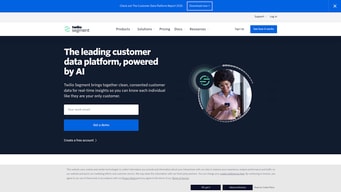

Unclaimed: Are are working at Segment ?
Segment Reviews & Product Details
Segment is a customer data platform that consolidates data from multiple sources to provide real-time insights and enhanced customer profiles. It enables businesses to personalize customer interactions by using AI-driven predictions and recommendations. Segment offers tools and integrations that help streamline data collection, management, and activation for targeted marketing campaigns and customer relationship management.

| Capabilities |
|
|---|---|
| Segment |
|
| Ease of use |
|
| Deployment | Cloud / SaaS / Web-Based |
| Support | 24/7 (Live rep), Email/Help Desk, FAQs/Forum, Knowledge Base |
| Training | Documentation |
| Languages | English |



I love how many destinations and sources segment supports. I can easily send data from websites, backend and frontend web applications to wherever I need it to go, even if it's multiple places. Excellent for setting up user analytics, admin dashboards, etc.
Sometimes it can be challenging to configure services like intercom or mixpanel on the frontend when the configuration options are obfuscated by the analytics library, but it's a small learning curve that's worth doing.
Data warehousing of user data, building admin dashboards and aggregating data from multiple sources with ease
The guidance they give on best practices for instrumentation, and the ease with which you can set your data up to go to new destinations.
There are certain limitations on how the data needs to be structured for downstream destinations.
All in-product tracking for our digital product (across Android, iOS, Web). It has allowed us to generate insights about how people use our products that would have been impossible before.
I like to only have to integrate 1 SDK to my app and be able to send the data to different products such as Mixpanel, Customer.io, Branch and so on.
I would say that the only thing I dislike is the documentation that can quickly become outdated, comes a new Swift update or a new product changes. It can be frustrating to be facing an outdated documentation, or the docs display code that won't compile.
We're analyzing how our users use the app, we're sending data to Mixpanel, we're tracking views, events, etc. The benefits are that we're not clueless about what people do with the app! I think it's quite obvious benefits.
Using Segment is not only time saving in terms of dev-ops, but it gets your smarter by asking yourself the right questions. What to use and how to generate actionable insights. Do I need to mention documentation is great.
I wouldn’t talk of downsides. In order to make it work, you need to plan ahead.
Building and tweaking a marketing stack that works for whatever it is you need to do.
I love it that Segment has integration with, well, almost every worthy service on this planet
Sometimes some of the events don't go through all the integrations. I assume this may be a problem with the integrations themselves.
Pushing analytics events to all external services to my product
Segment removes engineering requirements from connecting data to new products and managing the flow of data in your organization
Cost - many of the great features are behind the Business tier which is materially more expensive that the Team tier.
Centralized data structure, available to relevant tools, sync with data warehouse, ability to route data to new tools.
The power of segment to show real time valuable insights and its ease to connect with lot of destinations.
There is nothing that I can term as negative with regard to segment. Segment is really marvelous. Before using Segment we were not sure about market fit of our product but after connecting segment with Google Analytics and subsequent implementation of Visual Tagger we were able to visualize our real time data and were able to track our unique website visitors. It helped us in improving our customer experience and to significantly reducing our bounce rate. As a result of our product validation we were able to get funding commitments from investors. In my view startups can use the power of segment to visualize their customer insights and to show real time statistics to their stakeholders. Though there are many analytics providers but in my experience they are very few who track your unique users on monthly basis. Segment is great in this way to help you avoiding duplication of views on your product pages which can add to your credibility.
Product Validation and Market Fit. We are also using Segment to improve our customer experience.
At its core, the promise is unified user-level analytics. And that's delivered. On top of that though, is a product that technical leads are usually ok with, since it saves them time and resources as well. It's hard to argue against the cost/benefit, and the possibility of building your own with their open source repos is always there.
I think the pricing model is an issue for businesses with a lot of anonymous traffic if they want to use the managed analytics.js though Segment.
As a consultant, it's a very interesting tool because it brings business, marketing and technical teams together. The core promise to each of those groups is already a huge benefit ( Business: unified analytics & data, Marketing: faster/better/more relevant personalised comms, Technical: the last 3rd party API you'll integrate). But, apart from that, a lot of synergies and catalysts for growth have come from these teams being able to work together and have a common ground for making/discussing/weighing up decisions.
Once you install Segment you can send choose your downstream services in one slick and remove engineering from the mix as you add on more tools and services.
Some of the best features are only available on the business plan which is much more expensive than the team plan.
Unifying all of our user and analytics data transmission between tools, allowing us flexibility to choose the right tools with limited spin-up time, making it much quicker to add tracking and test before deploying.
I think the Personas product is a game changer to help in alleviating the reliance on developer involvement for Customer Journey Optimization
The pricing can be a little challenging for non-enterprise companies
The key to the methodology I employ with my clients is to empower non-technical team members to experiment and iterate without developer involvement. Segment is core to this strategy as once the data is pushed to segment, it can be pushed to anywhere else without developer involvement.